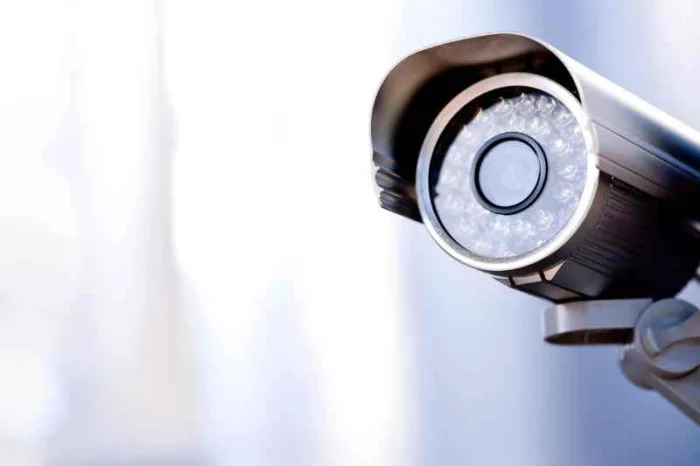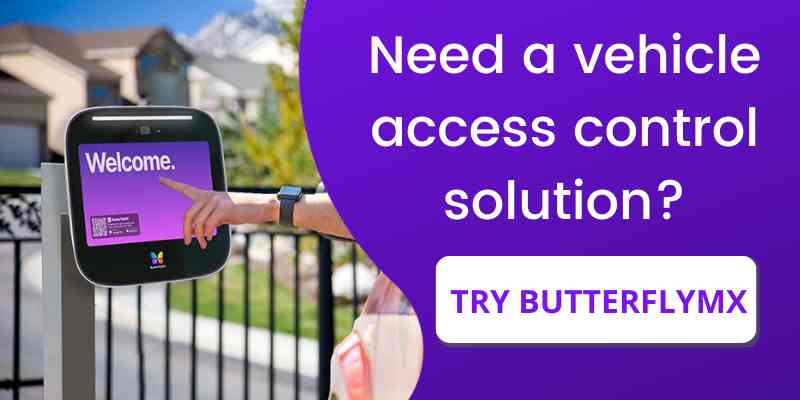Key takeaways
- An LPR camera scans the letters and number of a license plate to determine if access should be granted.
- A few good qualities of license plate readers include searchable logs, zoom or bullet cameras, and integrations.
- License plate recognition systems are usually expensive and may not integrate well with other access control or proptech solutions.
- LPR camera systems are commonly used in commercial buildings or offices, apartment buildings, and parking areas.
- Vehicle readers with windshield stickers and video intercoms are great alternatives to LPR systems.
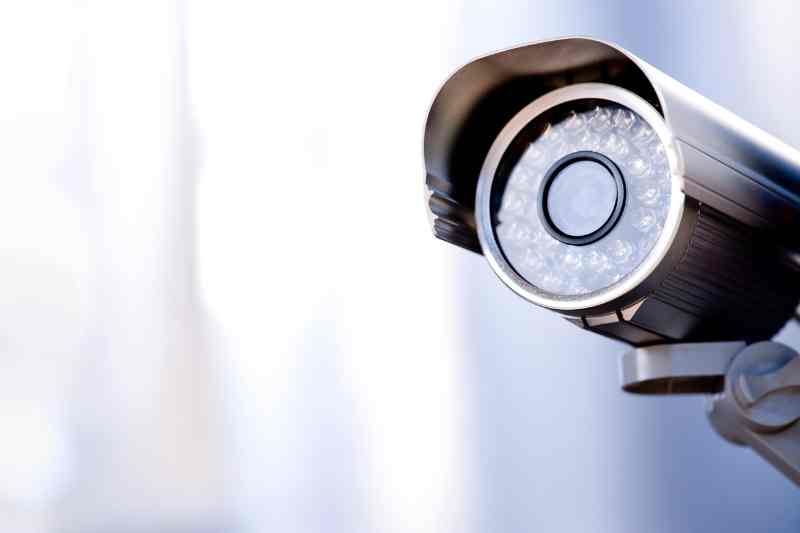
Simple and secure access is vital for both residential and commercial real estate. With this in mind, an LPR camera is one effective way to control access to parking at your property.
But what is an LPR camera, and how do you choose the right one for your building?
Well, read on to learn everything you need to know about LPR cameras and how they work. Then, discover some robust alternatives to LPR cameras that you should consider instead.
In this post, we cover:
- What is an LPR camera?
- How do LPR cameras work?
- What makes a good LPR camera?
- Where are LPR cameras used?
- Challenges of LPR cameras
- Alternatives to LPR cameras
What is an LPR camera?
A license plate recognition (LPR) camera scans a vehicle’s license plate to determine whether the driver is authorized to enter the property. The camera is part of a larger LPR system, which reads the plate number and checks it against the system’s database. If the plate is registered in the system, access will be granted.
These specialized cameras are incredibly precise at capturing and digitizing images from license plates with about 99% accuracy. They also read plates in as little as just 20 milliseconds. As a result, this makes them an effective vehicle access solution.
Additionally, this technology is commonly used to control access to gated communities and other non-residential properties. In these scenarios, the property’s gate automatically opens once the system recognizes and approves a registered vehicle’s license plate.
However, license plate reader cameras are also commonly used by law enforcement as traffic light cameras to get a clear image of a car’s license plate after they’ve sped or run a red light.
In addition to access control and traffic light cameras, LPR cameras are used in a variety of ways, such as:
- Ticketless parking systems
- Drive-throughs
- Car washes
- Toll roads, gates, and booths
- Other law enforcement uses
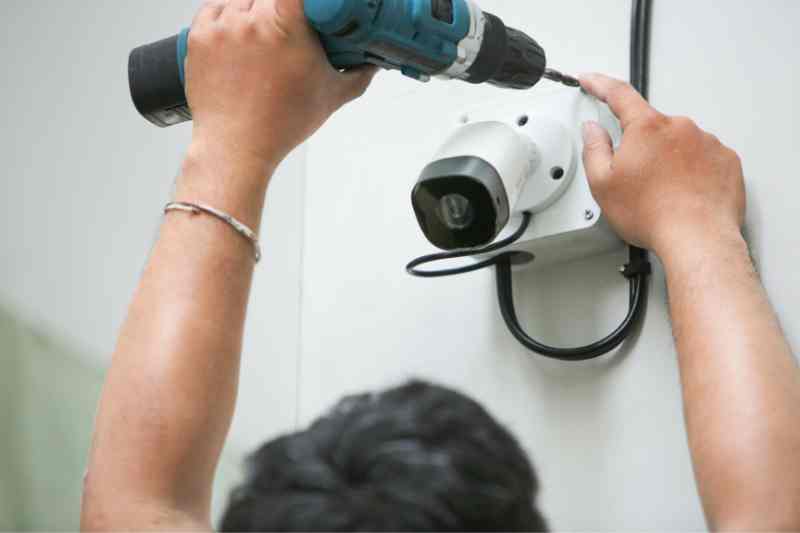
What is the difference between LPR and ANPR?
LPR (license plate recognition) and ANPR (automatic number plate recognition) mean basically the same thing, so it’s common to see these terms used interchangeably.
As a result, the difference between these two acronyms often comes down to specific providers, how they brand and characterize their products, and the type of services they provide.
What is the difference between CCTV and LPR cameras?
CCTV cameras are different from LPR cameras because they’re designed to capture general activity, whereas LPR cameras recognize and extract license plate information.
Furthermore, CCTV cameras have a lower picture quality, especially at night. Since these cameras are only meant to capture broad activity, they are unable to pick up finer details. Conversely, LPR cameras easily capture license plate details from cars traveling up to 120 mph.
How much does an LPR camera cost?
The cost of an LPR security camera can vary depending on the quality of the camera and the range of features it offers. CCTV cameras typically cost $300 – $500 on the lower end. However, they can cost upwards of $1,000 – $5,000 per camera, depending on the type of system used.
How do LPR cameras work?
ANPR camera systems use a specialized camera to scan images of license plates. Once this image is generated, the camera feeds this data to software that identifies the characters of the plate before converting it into an electronic format.
After converting the data, the system compares it against its database of registered users. If the license plate matches a registered user, they’ll be granted access.
Do LPR cameras work at night?
Yes, LPR cameras use infrared to read license plates in total darkness or low-light conditions.
Learn more about ButterflyMX vehicle access control:
What makes a good LPR camera?
There are several qualities to look for when choosing the best LPR camera for your building.
Qualities to consider:
- Zoom or bullet cameras. Zoom cameras (also known as bullet cameras) zoom in on license plates and generate clear images with incredible precision. As a result, they provide the most accurate reading of license plates.
- Multi-camera playback. Multiple cameras capture valuable contextual images of the vehicles that enter your property. As a result, this significantly reduces any errors when granting access to users. For best results, install several cameras to accurately track and monitor the cars that enter the premises.
- API integration. API integration exports the data from your LPR camera to other databases. This allows you to connect your LPR system with other gate access control and proptech solutions.
- Searchable logs. Choose an LPR camera software that offers searchable logs that allow you to search the database for suspicious license plates. Additionally, this software makes it easy to access video footage of every car that enters your property.
- Fuzzy matching. Fuzzy matching or fuzzy logic is a type of AI that’s designed to provide a more accurate reading of license plates. For instance, if your system registers an O character as a 0, the system is programmed to recognize this error. What’s more, these systems give administrators the ability to access logs and correct any license plate-capturing errors so that the plate is read correctly.
Where are LPR cameras used?
Plate recognition technology is used in a variety of ways to automatically grant access to residents, staff, and visitors.
Here are a few use cases for LPR cameras for different kinds of properties:
- Apartments and gated communities
- Commercial buildings and offices
- Student housing
- Parking lots and garages
- Coworking spaces
1. Apartments and gated communities
Plate recognition cameras are a convenient access control solution for residential properties because they allow for seamless visitor management.
Residents manage access for their guests by registering recurring visitors’ license plates to quickly authorize them for entry. This results in seamless visitor management since the camera can scan the guest’s license plate and allow them to enter.
This technology can be used to let in visitors like family, friends, dog walkers, and professional cleaners.
2. Commercial buildings and offices
Automatic plate recognition cameras quickly grant access to staff, visitors, and any authorized user who’s been registered in the system for seamless access control. A CCTV system is great for parking structures at commercial properties. This streamlines access by allowing administrators to monitor who’s entering the property and when.
3. Student housing
One of the most common security concerns at college campuses and universities is the ability to monitor and manage access to student and staff vehicles. An LPR camera allows students, faculty, and staff to securely access parking areas or gated neighborhoods on college campuses with ease.
To use an LPR camera effectively, simply register every student, faculty member, and staff’s vehicles at orientation or at the beginning of each semester.
4. Parking lots and garages
License recognition cameras are an ideal parking access control solution because they reduce the risk of unauthorized vehicles entering your parking facilities. Consider monetizing your parking garage or lots by allowing users to pay to temporarily register their license plate in the system or limit access to tenants and staff at your building.
5. Coworking spaces
Automatic plate recognition cameras are an effective way to implement physical access control at your shared coworking space’s parking garage or lot. Workers who are registered at your building can enroll their license plates into your LPR system for quick and easy access to your office’s parking structure.
Challenges of LPR cameras
Plate recognition cameras are a decent option for vehicle access control, but they come with a few challenges to consider before implementing one at your property.
Here are some common drawbacks of LPR cameras:
- High cost. High-quality LPR camera systems can cost tens of thousands of dollars depending on the number of cameras you install. This cost skyrockets even more, depending on the kind of software your system uses.
- Limited software compatibility. License recognition systems are not as effective when they don’t integrate well with other access systems and proptech.
- Additional hardware. Most LPR systems require additional hardware to work effectively. This often leads to a time-consuming and expensive installation process. What’s more, LPR cameras may require an LPR-dedicated NVR (network video recorder) that serves as the main hub for device recording and data storage.
- Limited users. Some LPR cameras only register a limited number of users, which isn’t ideal for large businesses or multifamily apartment buildings.
- Requires tenants to register visitors. Some systems only work for visitor access if the guest has been pre-registered before arriving. If the guest hasn’t been registered, you’ll need a separate system in place to allow them to request property access.
- Unclear license plates. The camera may not get a clear reading if a vehicle’s license plate is covered in snow or has visible damage. As a result, a security officer or staff member may have to manually enter the license plate number to grant access.
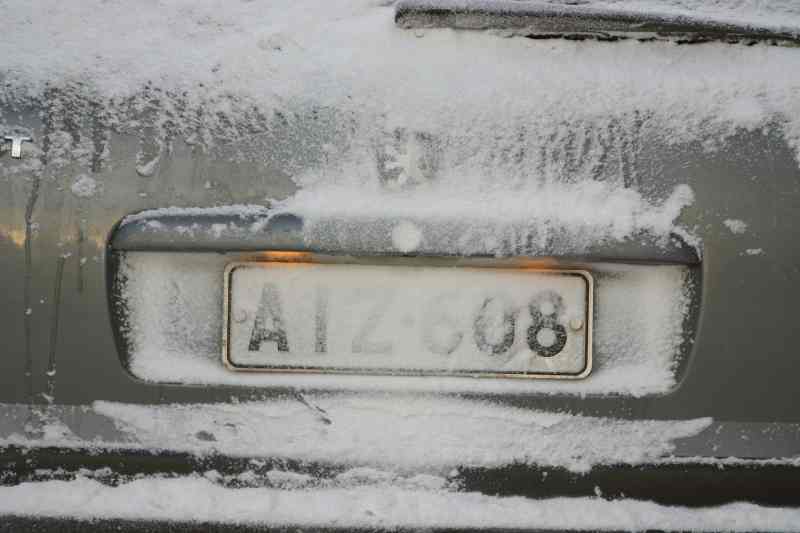
Alternatives to LPR cameras
These specialized cameras have several drawbacks, but the expensive cost of purchasing and maintaining them is one of the most pressing concerns. Luckily, there are a couple of viable alternatives that can streamline vehicle access at your building.
More specifically, ButterflyMX vehicle readers with windshield stickers and video intercoms are both great options to consider.
Vehicle readers and windshield stickers
ButterflyMX vehicle readers and windshield stickers are an affordable alternative to LPR cameras for tenant access because it’s more affordable. Not to mention, vehicle readers integrate with other ButterflyMX access control products, allowing you to manage your entire access control solution in one place.
Additionally, windshield tags can be distributed to any number of drivers, whereas LPR systems are often limited in the number of users. In the event a windshield tag is removed from a vehicle, it peels off in pieces, preventing it from being used again.
Vehicle tag reading systems work by scanning the sticker when someone pulls up to your gated entrance. Best of all, the driver doesn’t have to fumble for their credentials or roll down their window to gain access.
Video intercoms
Alternatively, video intercoms act as an effective vehicle access solution. Video intercoms allow staff and residents to launch two-way video calls with visitors so they can verify their identity before granting them access.
Furthermore, users can also issue temporary Visitor Passes to guests so they can quickly and easily access the building. Additionally, these Visitor Passes can be set to expire after one use, or you can set them to function only during specific days or times. As a result, you don’t have to worry about visitors continuing to use their Visitor Passes past their expiration.
With both of these visitor access methods available, residents don’t have to pre-register their visitors or know their guests’ license plate numbers.
What’s more, ButterflyMX video intercoms allow tenants and staff to open doors and gates with just a swipe of their smartphones. Additionally, the ButterflyMX video intercom accepts PIN codes or key cards and fobs if a user’s phone is lost or dies.
